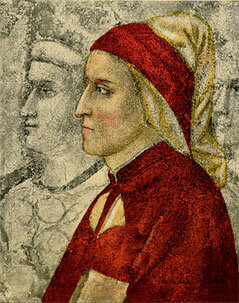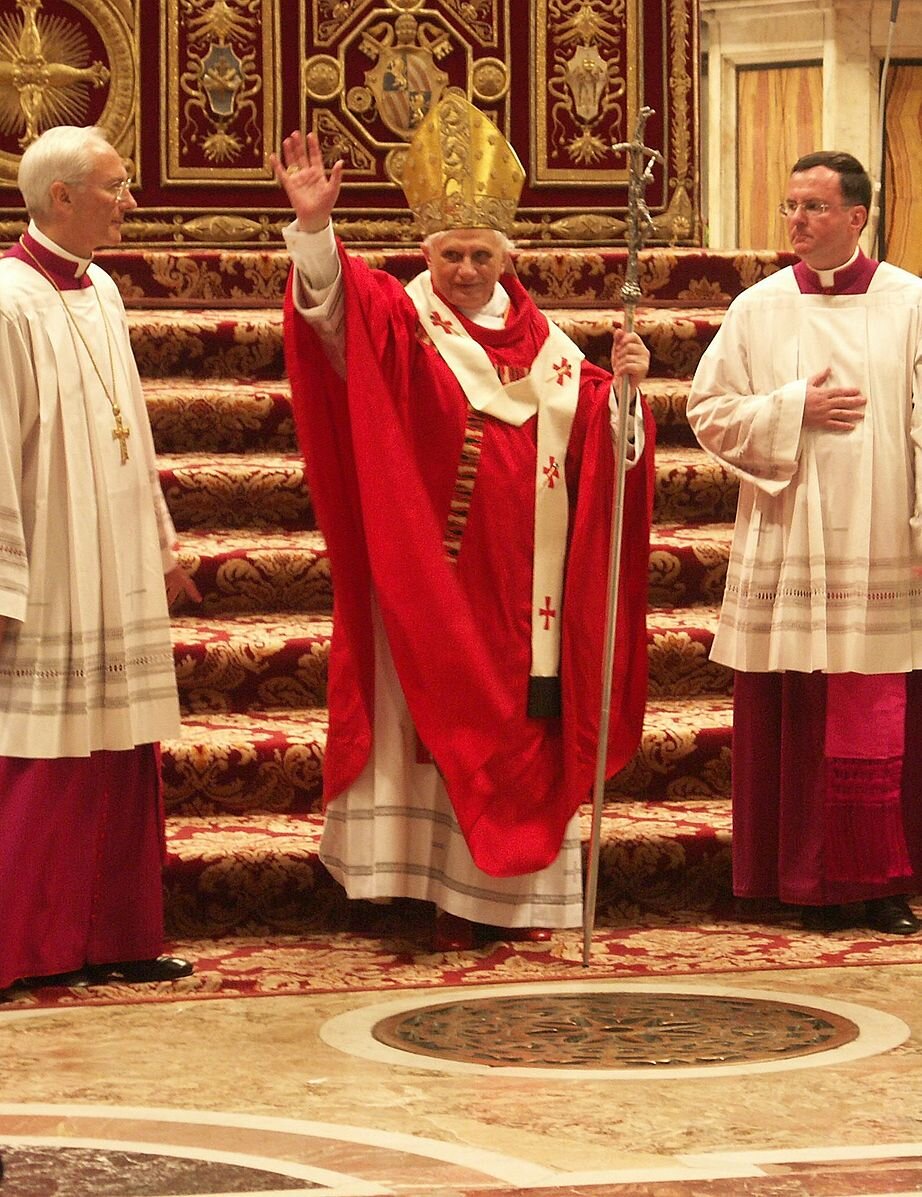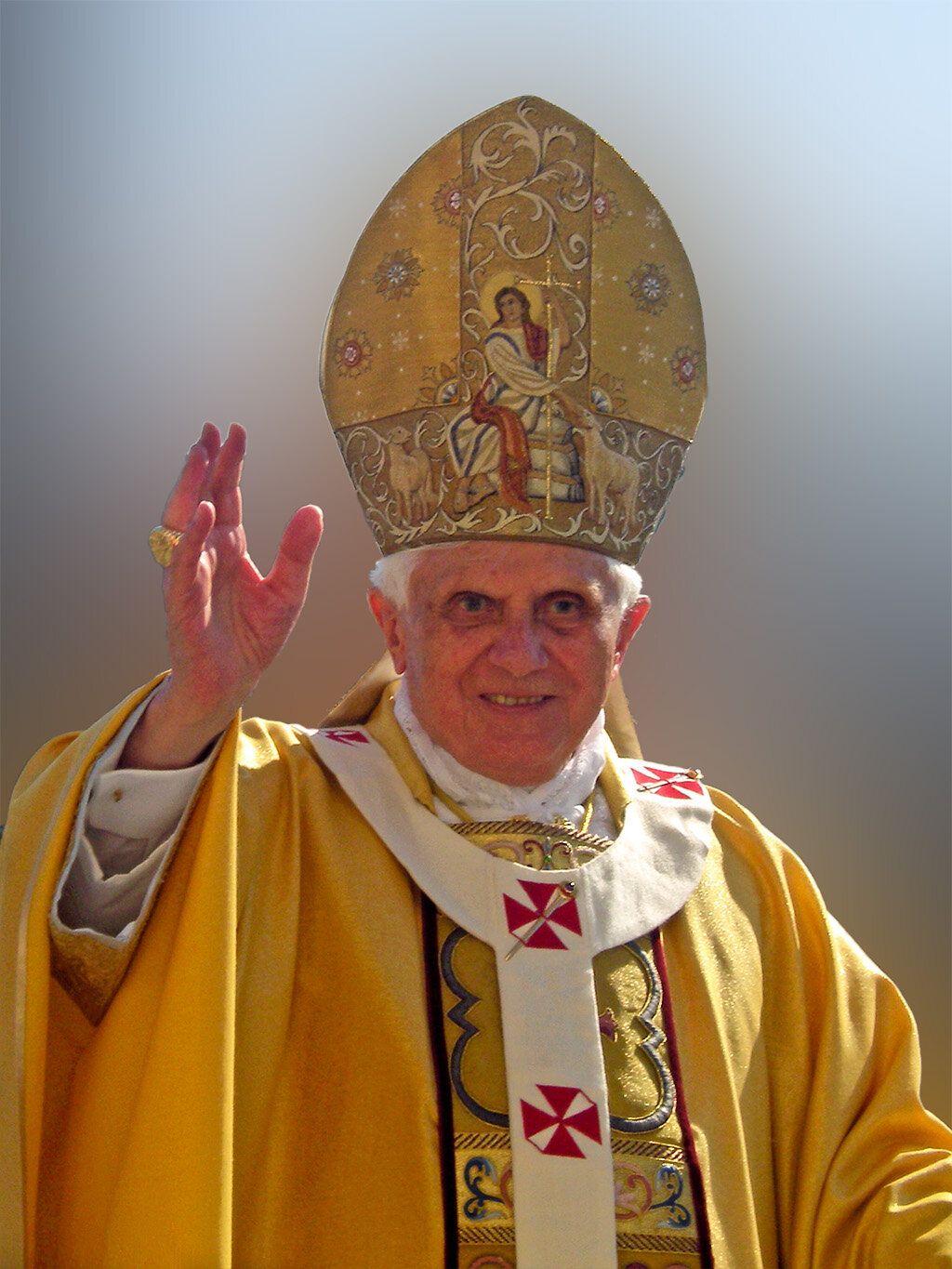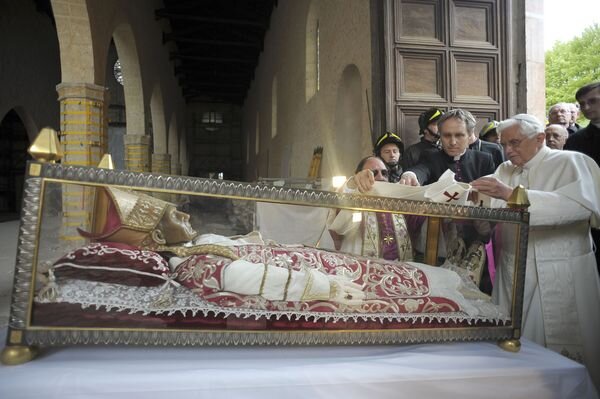Runaway Pope: The Saint Dante Condemned to Hell's Antechamber
Four years ago, on February 11, 2013, Pope Benedict XVI shocked me along with the rest of the world when he announced he would be resigning from the papacy on February 28. Recently I have been reading and thinking quite a bit about Pope St. Celestine, who also resigned—719 years before Pope Benedict—on December 13, 1294, and who was the only other pope who ever voluntarily stepped down from the papacy. One thought-provoking contradictory fact about St. Celestine is that although he is a canonized saint, the great poet Dante doomed him to eternal suffering in the anteroom of hell. Many other aspects of the life of this sainted hermit monk who became pope against his will are equally bizarre and fascinating, including the fact that he ran away twice from the papal role that was forced upon him.
I first started thinking again about Pope Celestine V a few days ago because I ran across and was struck by a painting of Dante and Virgil in a scene from Inferno Canto III. The painting portrays the moment that Virgil encourages Dante to overcome his fear and pass trustfully through the gate of hell in spite of the terror-inducing warnings on the sign at its top: “All hope abandon, ye who enter here.”
“Canto 3 Dante and Virgil approach the mouth of hell and see the sign ‘Abandon hope, all ye who enter here.'” by Eric Armusik, b. 1973 (Armusik: Classical Figurative Artist)
My interest piqued by the painting, I re-read Canto III in the Inferno to refresh my memory about what happened next. After Dante and Virgil pass through Hell’s Gate: they enter into the anteroom of hell.
Dante is moved to tears when he hears the lamentations and moans of the first group of sinners they encounter there. Virgil tells Dante that the miserable souls in hell’s anteroom are the uncommitted, those who never took a stand for either good or evil, and who are eternally rejected by both heaven and hell; Virgil doesn’t want to waste any words or time on them. He tells Dante, “Speak not of them, but look, and pass them by.”
When Dante looks, he sees unimaginable numbers, more than all the people he had previously believed had ever died before, who race around naked in endless pursuit of a blank banner. They are tormented by swarms of stinging wasps and hornets, while—adding to the horror—maggots and worms drink the tears and blood that drop to the sinners’ feet. Among the screaming, racing, tormented throng are those angels who did not take a side when Satan and his minions rebelled against God.
Dante is able to make out in the darkness one recognizable figure, whom he does not name.
I saw and recognized the shade of him
who due to cowardice made the great refusal.”
—Inferno III, 59–60
Dante (contemporaneous portrait by Giotto painted just before Dante’s exile), Bargello Palace, Florence
Dante (born 1265) must have been well aware of the events of the reign and abdication of Pope Clementine V because he was around twenty-nine years old during the Celestine papacy which began and ended in 1294. Dante was banished from Florence in 1302 at the age of 37, and he started to write the Commedia, which includes the Inferno, around 1308.
A definite identification of Pope Celestine V as the unnamed figure who made the Great Refusal was made by Jacopo Aligheri, Dante’s son, who went into banishment with his father and brother. Here is a loose translation of the relevant part of Jacopo Aligheri’s commentary on Inferno 3.58-60:
The Pope of Rome, named Celestine, who for cowardice of heart, fearing others, refused the great apostolic office in Rome.”
Celestine V was canonized by Pope Clement V in 1313, and he is referred to as Saint Celestine or Saint Peter Celestine. Canonization is an affirmation that the saint is in heaven. So it was quite a bold contradiction for Dante to portray Celestine V in the Inferno, which was probably completed four years after the canonization in 1317, as doomed to spend eternity in endless suffering.
Not everybody agreed with Dante’s assessment, of course. Petrarch, whose love of the solitary life was extreme, wrote in “De vita solitaria” in 1346, that Celestine’s refusal was as a “virtuous example of a man choosing the solitary life as a way of perfection.” Another writer of the time, Benvenuto da Imola wrote that Celestine did not abdicate out of “meanness of spirit.” He wrote, “I regard it as the action of a mind highly exalted and emancipated, knowing no yoke and truly celestial, and so I feel that it could have been performed only by a man who estimated human things at their true value and trampled beneath his feet the proud head of fortune.”
Could Dante be right that St. Celestine was a coward who left the papacy because of fear? Or were Petrarch and da Imola right in their belief Celestine chose the better way? Was he merely a simple, holy man who realized he was in over his head? Should he have trusted God’s calling? Would it be better if he had stayed and followed the words of St. Paul, who wrote that he had learned “in whatever state I am, to be content”—Philippians 4:11. What do you think?
Further down in this piece, I will provide some more details about his life that can help to establish what kind of a man St. Celestine was. But first, I want to consider this question:
What could have led Dante to assign a canonized saint to such a harsh fate?
Why Put a Saint in Hell’s Vestibule?
Dante hated cowards, and he saw St. Celestine’s abdication as a cowardly act. Many commentators say that Dante detested Pope Celestine’s resignation of the papacy so extremely mostly because it allowed Benedict Caetani become the next pope, Boniface VIII. Pope Boniface VIII was Dante’s much-hated foe on the opposite side of a dispute among churchmen and secular rulers that led to Dante’s banishment from his beloved city of Florence.
After Boniface VIII sent Charles of Valois to Florence to secure papal power there, Dante had gone to Rome to negotiate about Florence’s future, and while Boniface deliberately detained Dante in Rome, Charles of Valois entered the city. Charles’ intervention in Florence resulted in massive bloodshed and destruction of property and also led to the overthrow of the ruling White Guelphs, Dante’s political party. Dante’s property was confiscated and Dante’s long exile began.
Although Dante did not mention Celestine V by name, he did not hesitate to mention Boniface VIII several times by name and placed him into hell for simony. At the fictional date of the poem’s timeline, Boniface was still alive, so Dante has Pope Nicholas III mention Boniface’s prophesied arrival when Dante encounters Nicholas III in the eighth circle of hell. Later in the Inferno, Dante mentions Boniface’s false promises to the Colonna family with whom he feuded and his demolition of the city of Palestrina, with the killing of the Colonnas along with a total of 6,000 citizens and destruction of both the home of Julius Caesar and a shrine to Our Lady. Boniface’s fate is also mentioned by Beatrice to Dante in Paradiso.
Who Was Celestine V?
The holy hermit who would later be elected Pope Celestine V in a tumultuous set of circumstances was born about the year 1221 in Sicily. He was baptized Pietro then later came to be called Pietro del Murrone (Peter of Morrone) because of the cave on Monte Morrone where he lived as a hermit and where he later established his religious order. During his childhood, Peter practiced extreme penances and constant prayer until, at the age of twenty, he went to live a solitary life in a small underground cell he dug on a mountainside. He was ordained priest in Rome but left to return to life as a hermit on Mount Morrone. When the wood on his mountain was cut down five years later, he moved with two companions to an even more remote and inaccessible spot, on Mount Magella. Peter always lived a zealously austere life, modeling himself after St. John the Baptist.
“Peter spent always the greatest part of the night in prayer and tears which he did not interrupt, while he was employed in the day in corporal labor or in copying books. His body he always treated as a most dangerous domestic enemy. He never ate flesh; he fasted every day except Sunday. He kept four lents in the year, during three of which, and on all Fridays, he took nothing but bread and water, unless it were a few cabbage leaves in lieu of bread. The bread which he used was so hard, that it could only be chopped in pieces. His austerities were excessive, till he was admonished in a vision not to destroy that body which his duty to God required him to support. St. Peter wore a shirt of horse-hair full of knots, and a chain of iron about his waist. He lay on the ground, or on a board, with a stone or log of wood for a pillow.”—The Lives or the Fathers, Martyrs and Other Principal Saints by the Rev. Alban Butler.
When news of his holiness spread, many devotees flocked to him, and he reluctantly returned to Mount Morrone, where there was enough space for his followers to live near him in rude shelters. In 1271 he received Pope Gregory X’s approval of his religious order under the rule of St. Benedict, which he restored to “primitive severity.”
I mentioned the tumultuous times: After the reign of Gregory X, which ended in 1276, there were seven popes in rapid succession in the twelve years before Pope Nicholas IV was elected in 1288. Then after Nicholas IV died in 1292, the see of Peter stood vacant for two years and three months because the cardinals and the secular rulers who were always trying to control them could not agree on a successor. By some accounts, Peter wrote a letter admonishing the cardinals that if they didn’t elect a new pope within four months they would face the wrath of God. Other accounts say that one of the cardinals called out that the holy monk, Peter Morrone, should lead the Church. In either case, the cardinals responded by electing Peter as pope. At the time he was elected Peter’s order had six hundred monks. He was the first founder of an order to be elected Pope. Huge crowds numbered at 200,000 (again according to the Catholic Encyclopedia) flocked to Peter’s isolated monastery at the news of his election.
The way Butler continues the story, when Peter found that no one would accept his many objections about his unfitness to fulfill the duties of the papacy, Peter tried to flee with Robert, one of his monks, but they were intercepted. This marked is the first time that Peter was a runaway pope, if Butler’s account is true—but it would not be the last.
With great tears of shock and fear and mourning, Peter at last reluctantly agreed with those who cajoled him to accept his election as Pope as the will of God. He refused to ride a white palfrey to his coronation, but insisted on riding an ass. “If I must ride at all,” he said, “there is no beast so well beseems me. It was good enough for Him.”
He took the name of Celestine V. His religious order has been called the Celestines ever since. He wore his papal vestments over his monastic habit, which he refused to remove.
After he became pope, he seems to have done just about everything wrong:
It is wonderful how many serious mistakes the simple old man crowded into five short months. We have no full register of them, because his official acts were annulled by his successor.”—”Pope St. Celestine V,” Catholic Encyclopedia (1908)
Here are some examples of why many see his reign as a disaster. As Pope, St. Celestine refused no one whatever he was asked, and he prodigally gave away benefices, often to than one person. He attempted to get his fellow clerics in the Church to live strict lives of penance and holiness, predictably without success and with much stirring up of resentment. He tried to continue living his austere way of life by building and living in a cell of boards in his apartment in the papal palace. He also tried to live Advent with the severe penances and in the isolation he was accustomed to, but his designation of three cardinals to run the Church while he was sequestered was highly criticized. Things fell into chaos. He verified with Cardinal Benedict Cajetan, a canon lawyer and skilled statesman, that a pope actually could step down. Then, he issued a formal decree allowing popes to abdicate, and he abdicated himself on December 13, 1294. The reasons given for his abdication were:
The desire for humility, for a purer life, for a stainless conscience, the deficiencies of his own physical strength, his ignorance, the perverseness of the people, his longing for the tranquility of his former life.”
Cardinal Cajetan was elected to succeed him, chose the name Boniface VIII, and was crowned at Rome on January 16th, 1295. The only act of Celestine V that Boniface VIII did not nullify was the decree allowing a pope to abdicate.
Peter Runs Away A Second Time
After abdicating, St. Celestine took off his papal vestments and re-assumed the name of Peter—and then he ran away again.
Many rumors floated around, that Boniface had forced him out, that it was not legally possible for a pope to resign, that Celestine was still pope. Boniface VIII was afraid that Celestine might be set up as an anti-pope. The Catholic Encyclopedia tells us Peter escaped the custody of Pope Boniface, who was taking him to Rome with him. Peter visited his monks on Mount Majella and then managed to evade his pursuers for several months by wandering through woods and mountains. Think of it, a man in his seventies hiding out in the trees!
Peter’s Tiny Cell
Peter's Tiny Cell
Finally Peter attempted to escape to Greece by sea, but he was driven back to land by a storm, where he was captured and brought back to Pope Boniface. Boniface kept him some time in his own palace, then confined him for the rest of his life in a tiny cell in the citadel of Fumone, guarded by soldiers and cared for by two of his religious brothers. The photo shows his tiny cell.
Peter was insulted by his guards, and his caretakers were restricted in what they were allowed to do for him, but he returned kindness to every insult and did not complain. He used to say: “I desired nothing in the world but a cell; and a cell they have given me.” After ten months’ imprisonment, he died at the age of 75 on May 19, 1296. Many miracles were attributed to him after his death.
Prefiguration: Benedict XVI Visits Celestine’s Remains, Twice
St. Peter Celestine’s glass coffin lies in Santa Maria di Collemagio, a basilica in the city of L’Aquila near the mountains where he lived as a hermit, the same basilica where he was consecrated and crowned as pope. The basilica was badly damaged during the 2009 L’Aquila earthquake. When the saint’s remains and his glass casket survived, one Italian spokesman said it was “another great miracle by the pope.”
In a trip to inspect the earthquake damage and console the inhabitants of the area, Pope Benedict XVI also visited St. Celestine. In an unusual gesture whose possible significance was noticed only later, after a brief prayer, Pope Benedict left his unique pallium, the lamb’s wool stole of papal office that was conferred on him during his papal inauguration in April 2005, on Celestine’s glass casket. It was not that he was giving away his papal power at that time. He had already “retired” that pallium from use and was using a smaller one of a different design, which he continued to use for the rest of his reign as pope. But it still seems a portentous gesture, although few people noticed the gesture at the time.
Below Left: Benedict XVI’s First Papal Pallium. Right: Second Papal Pallium
Benedict XVI Leaves His First Pallium With St. Celestine
The remains of St. Celestine were temporarily moved to Sulmona while the cathedral was repaired, and Benedict visited the saint there again. While in Sulmona, Benedict said these words to the young people of the city about the choice St. Celestine made of a hermit’s life and its benefit to the life of the Church:
Perhaps you will say to me: but if we look, for example, at St Peter Celestine, in his choice of the heremitical life might there not have been individualism or an escape from responsibility? This temptation does of course exist. But in the experiences approved by the Church, the solitary life of prayer and penance is always at the service of the community, open to others, it is never in opposition to the community’s needs. Hermits and monasteries are oases and sources of spiritual life from which all may draw. The monk does not live for himself but for others and it is for the good of the Church and of society that he cultivates the contemplative life, so that the Church and society may always be irrigated by new energies, by the Lord’s action.”
Mater Ecclesiae Monastery in the Vatican Gardens where Pope Emeritus Benedict XVI lives after his retirement
Four years later, Benedict XVI used the decree put in place by St. Celestine and resigned from the papacy. Now he lives in a monastery in the Vatican Gardens and prays for the Church. He appears in public only on the invitation of Pope Francis, who was installed as pope on March 13, 2013.In these words that Pope Emeritus Benedict XVI spoke when he announced his resignation, we can hear some echoes of the reasons St. Celestine gave when he retired:
“After having repeatedly examined my conscience before God, I have come to the certainty that my strengths, due to an advanced age, are no longer suited to an adequate exercise of the Petrine ministry. I am well aware that this ministry, due to its essential spiritual nature, must be carried out not only with words and deeds, but no less with prayer and suffering. However, in today’s world, subject to so many rapid changes and shaken by questions of deep relevance for the life of faith, in order to govern the barque of Saint Peter and proclaim the Gospel, both strength of mind and body are necessary, strength which in the last few months, has deteriorated in me to the extent that I have had to recognize my incapacity to adequately fulfill the ministry entrusted to me."










